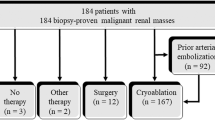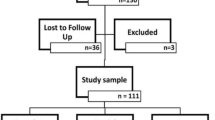Abstract
Among 230 patients undergoing ultrasound (US) guided renal biopsy, 218 had postbiopsy sonography. Clinical records were reviewed to correlate symptoms to US findings. In each case of large hematoma (thickness above 1 cm), all postbiopsy sonographic studies were analyzed to look for findings indicative of unfavorable outcome. A total of 96 subcapsular/perirenal hematomas were found. Large hematomas were observed in 20 patients (20/230=8.7%), seven of these (3%) were severely symptomatic. In the absence of clinical signs of bleeding, no patient had clinical consequences. In the presence of clinical signs of bleeding, serious complications occurred only in patients with large hematomas. US thickness of retroperitoneal hematoma correlated to clinical outcome: whenever measured thickness was less than 2 cm, clinical evolution was very favorable, whereas a thickness above 2 cm was invariably associated to clinical signs of bleeding. In six of seven cases of thickness exceeding 3 cm, severe complications developed. An unfavorable evolution was associated with increasing thickness and an echogenicity inappropriate with respect to the time elapsed since biopsy. Hydroureteronephrosis, peritoneal effusion, and anomalous vascular images were indicators of deterioration. We conclude that sonography is indicated only for symptomatic patients and that the monitoring of both thickness and changing echogenicity of retroperitoneal blood collections supplements clinical follow-up.
Similar content being viewed by others
References
Diaz-Buxo JA, Donadio JV. Complications of percutaneous renal biopsy: an analysis of 1000 consecutive biopsies.Clinical Nephrology 1975;4:223–227
Madaio PM. Renal biopsy.Kidney International 1990;38:529–543
Jorstad S, Borander U, Berg KJ, Wideroe TE. Evaluation of complications due to percutaneous renal biopsy: a clinical and angiographic study.Am. J of Kidney Diseases 1984;4:162–165
Wickre CG, Golper TA. Complications of percutaneous needle biopsy of the kidney.Am. J Nephrology 1982;2:173–178
Burstein DM, Schwartz MM, Korbet SM. Percutaneous renal biopsy with the use of real-time ultrasound.Am. J Nephrology 1991;11:195–220
Chevrette Y, Laperrière J, Quérin S, Béroniade V, Prosmanne O. La biopsie rénale sous guide échographique: une expérience de 2 ans.Radiologie J Cepur 1990;10:309–311
Chan JC, Brewer WH, Still WJ. Renal biopsies under ultrasound guidance: 100 consecutive biopsies in children.J Urology 1983;129:103–109
Muth RG. The safety of percutaneous renal biopsy: an analysis of 500 consecutive cases.J Urology 1965;94:1–3
Ralls PW, Barakos JA, Kaptein EM, Friedman PE, Fouladian G, Boswell WD, Halls J, Massry SG. Renal biopsy-related hemorrhage: frequency and comparison of CT and sonography.J Comput Assist Tomogr 1987;11:1031–1034
Nadel L, Baumgartner BR, Bernardini ME. Percutaneous renal biopsy: accuracy, safety and indications.Urol Radiol 1986;8:67–71
Bolton WK. Nonhemorrhagic decrements in hematocrit values after percutaneous renal biopsy.JAMA 1977;238:1266–1268
Mostbeck GH, Wittich GR, Derfler K, Ulrich W, Walter RM, Herold C, Haller J, Tscholakoff D. Optimal needle size for renal biopsy: in vitro and in vivo evaluation.Radiology 1989;173:819–822
Alter AJ, Zimmerman S, Kirachaiwanich C. Computerized tomographic assessment of retroperitoneal hemorrhage after percutaneous renal biopsy.Arch Intern Med 1980;140:1323–1326
Ginsburg JC, Fransman SL, Singer MA, Cohanim M, Morrin PA. Use of computerized tomography to evaluate bleeding after renal biopsy.Nephron 1980;26:240–243
Rosenbaum R, Hoffsten PE, Stanley RJ, Klahr S. Use of computerized tomography to diagnose complications of percutaneous renal biopsy.Kidney International 1978;14:87–92
Low RN, Jeffrey RB. Intraperitoneal hemorrhage after renal biopsy: a grave prognostic sign.AJR 1988;151:113–114
Middleton WD, Kellman GM, Melson GL, Madrazo BL. Postbiopsy renal transplant arteriovenous fistulas: color Doppler US characteristics.Radiology 1989;171:253–257
Author information
Authors and Affiliations
Rights and permissions
About this article
Cite this article
Castoldi, M.C., Del Moro, R.M., D'Urbano, M.L. et al. Sonography after renal biopsy: Assessment of its role in 230 consecutive cases. Abdom Imaging 19, 72–77 (1994). https://doi.org/10.1007/BF02165869
Received:
Accepted:
Issue Date:
DOI: https://doi.org/10.1007/BF02165869




